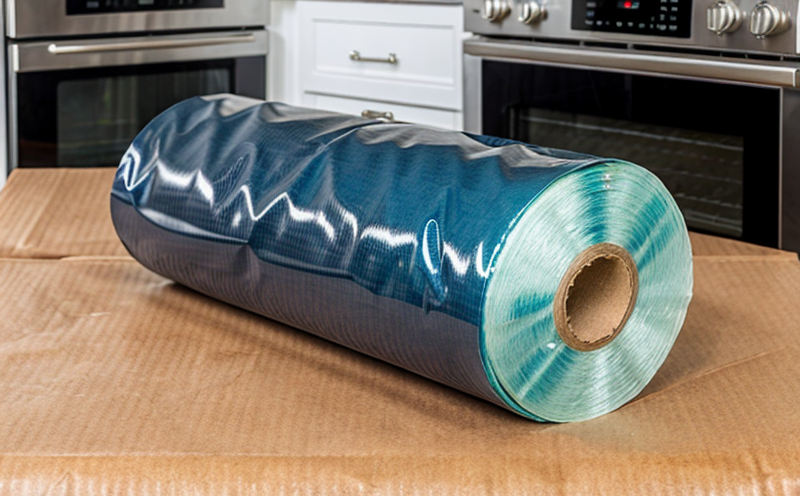JIS K 7136 Transparency Testing of Household Plastic Wraps
The JIS K 7136 transparency test is a critical procedure used to assess the clarity and optical properties of plastic films commonly found in household wraps, such as cling film or sandwich bags. This standard plays a pivotal role for manufacturers and quality assurance teams by ensuring that products meet specific optical performance requirements.
The test involves measuring light transmission through the film sample at various angles using an integrating sphere with a photometer. The results provide insights into how much light can pass through different sections of the plastic wrap, which is essential for packaging design and consumer expectations regarding visibility and clarity.
Manufacturers rely on this test to ensure that their products adhere to industry standards and customer needs, especially in applications where transparency is paramount. For instance, clear cling films are used not only in food storage but also in medical devices and electronic components, where visual inspection is necessary during assembly or use.
The JIS K 7136 standard is part of a broader suite of tests that collectively ensure the quality and reliability of household plastic wraps. These tests include dimensional stability, thermal aging resistance, mechanical strength, and chemical resistance, all of which contribute to the overall performance and safety of the product.
The test procedure itself requires precise specimen preparation. Samples are cut into standard sizes, typically 150 mm x 200 mm rectangles, and mounted in a holder that ensures accurate light transmission measurements. The integrating sphere is calibrated according to ISO standards to ensure consistent results across multiple tests.
Once the sample is prepared, it is placed between two polarizing filters within the integrating sphere. Light from a specified source illuminates the sample at a 45-degree angle, and the transmitted light is measured by the photometer. The test can be conducted under different conditions to simulate real-world use, such as varying temperatures or humidities.
The results of this test are reported in terms of percent transmission values for both visible and near-infrared light. These values help manufacturers understand how their product will perform in various environments and against competitive offerings. The data can also be used to make adjustments to the formulation, thickness, or manufacturing process to improve transparency.
For quality managers and compliance officers, understanding this test is crucial for ensuring that products meet both internal specifications and external regulatory requirements. It allows them to track trends in material performance over time and identify areas for improvement. In R&D settings, the test provides a benchmark against which new formulations can be compared.
For procurement teams, knowing about JIS K 7136 transparency testing helps in selecting suppliers who adhere to high standards of quality assurance. By specifying this test as part of their procurement requirements, companies can ensure that all incoming materials are consistent with the desired optical properties.
Why It Matters
The transparency test is not just a technical exercise; it has significant implications for both manufacturers and consumers. For manufacturers, ensuring high levels of transparency can enhance brand reputation and market competitiveness. Consumers expect products that meet their visual requirements, especially in food storage where clear films allow them to see the contents easily.
From an environmental perspective, maintaining consistent transparency standards helps in recycling processes by making it easier to identify different types of plastics through optical means. This can lead to more efficient sorting and processing, ultimately reducing waste and improving sustainability practices.
The test also plays a role in ensuring safety, particularly for medical devices or packaging that requires clear visibility during use. Any defects in transparency could affect the functionality and usability of these products.
Why Choose This Test
Selecting the JIS K 7136 transparency test is advantageous for several reasons:
- Industry Recognition and Compliance: The JIS standard is widely recognized in Japan, ensuring that products meet stringent quality criteria.
- Consistency and Reliability: The standardized procedure ensures consistent results across different labs and manufacturers.
- Educational Value: Understanding the test helps stakeholders make informed decisions about product development and procurement.
- Safety Assurance: Ensures that products meet regulatory standards, particularly in medical or food packaging applications.
Environmental and Sustainability Contributions
The JIS K 7136 transparency test contributes positively to environmental sustainability by enabling manufacturers to optimize their production processes. By ensuring that plastic wraps meet high transparency standards, companies can reduce waste associated with non-conforming materials.
Moreover, the test supports recycling initiatives by providing a reliable method for distinguishing between different types of plastics. This distinction is crucial for efficient sorting and processing in recycling facilities, which ultimately leads to less waste going to landfills.
For consumers, products that meet high transparency standards are often associated with better quality and reliability. This perception can influence purchasing decisions and contribute to a more sustainable consumption pattern where quality and environmental responsibility go hand-in-hand.





